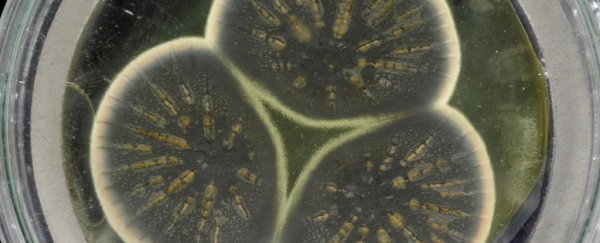In 1928, Scottish scientist Alexander Fleming made history. In a common mould - so common that the strain grew by accident in a petri dish of Staphylococcus - he discovered antimicrobial properties that he would exploit to develop the first mass-produced antibiotic drug, penicillin.
That original strain of Penicillium mould was cryogenically preserved decades ago - frozen alive for posterity - but now, for the first time, its genome has been sequenced. And much like the discovery of penicillin itself, the research evolved as the offshoot from something else.
"We originally set out to use Alexander Fleming's fungus for some different experiments," explained evolutionary biologist Timothy Barraclough of Imperial College London and Oxford University. "But we realised, to our surprise, that no-one had sequenced the genome of this original Penicillium, despite its historical significance to the field."
The newly derived sequence has been compared to two later, commercially produced Penicillium genomes from the US, allowing researchers to see how industrial-scale production has slightly changed the genetic makeup of the mould over time and distance.
Penicillium, and other moulds, produce antibiotic molecules naturally as part of their own defence systems against microbes. Since microbes evolve quite quickly to counter these defences - a trait that is currently causing quite a problem in the form of antibiotic drug resistance - moulds, too, evolve in response.
It's kind of like an arms race, on the microscopic scale, and studying exactly how the moulds evolve could provide some new insights into the problem of antibiotic resistance today.
"Our research could help inspire novel solutions to combating antibiotic resistance," said biologist Ayush Pathak of Imperial College London.
To conduct their research, the team thawed a sample of Fleming's Penicillium rubens, and re-grew it. That freshly grown mould was then sampled and sequenced. The resulting genome was then compared against the US strains.
Fleming's Penicillium may have been the founder of penicillin drugs in the UK, but in the US, industrial production started with a wild isolate from a mouldy cantaloupe. This strain was subjected to mutagenic treatments, such as irradiation with X-ray and ultraviolet light, and artificial selection to produce a strain with high penicillin production rates.
Any differences between the Fleming mould and the US mould are either the result of evolutionary differences in the wild cantaloupe strain, or the early steps into mutagenesis and artificial selection.
In comparing the two, the researchers looked at two kinds of genes - those that encode the enzymes that aid in penicillin production, and those that regulate the production of the same enzymes.
The Fleming mould and the US mould have pretty much the same genetic code for the regulatory enzymes, it turns out. Interestingly, the US mould had more copies - which would help those strains produce more penicillin.
That's not unexpected, since they were cultivated specifically for that purpose, but it does provide some insight into the results of the domestication process.
The encoding genes, however, were slightly different between Fleming's UK strain and the US strains. This, the team believes, was the result of natural evolution, probably in response to differences in the microbes that threaten the moulds in their local environments.
It's this naturally evolved difference that could be a key in helping develop solutions to the problem of antibiotic resistance.
"Industrial production of penicillin concentrated on the amount produced, and the steps used to artificially improve production led to changes in numbers of genes," Pathak said.
"But it is possible that industrial methods might have missed some solutions for optimising penicillin design, and we can learn from natural responses to the evolution of antibiotic resistance."
The research has been published in Scientific Reports.
